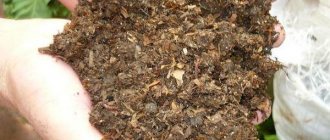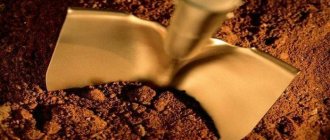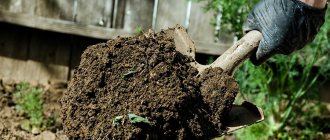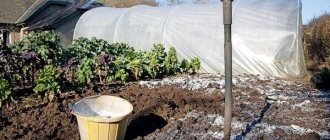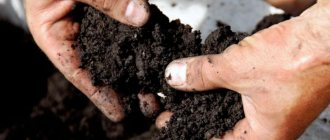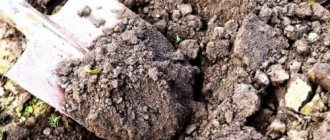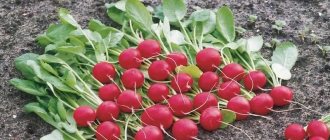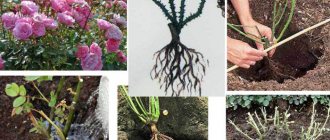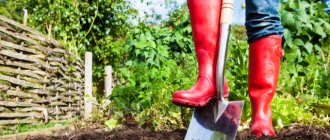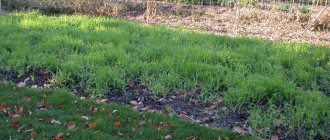Compost as a fertilizer cannot be replaced in organic farming. Depending on what bacteria are involved in its maturation, compost comes in two types. Aerobic, where the main role is played by aerobic bacteria, which require oxygen to live. Aerobic compost can be produced in large quantities, quite quickly. In addition, it is convenient to use. This is its advantage. Before using compost as a fertilizer, you need to understand what properties its types have.
Sandy soil is the type of soil with the largest grains. This is one of the light soils that works very easily. They are permeable to water and warm up very quickly, but cool down just as quickly as a sandy beach, which is hot during the day and cold at night. The soil sample is not loamy. and you can't give it almost any shape. When you rub the material between your fingers, you can feel the grain perfectly.
Loamy soil is heavy soil containing at least 35% clay. It completely absorbs water and nutrients - if it is exposed to heavy rainfall it becomes cloudy, if the sun is too strong it tends to dry out and become hard and cracked. Loamy soil heats up. The soil sample is black and shines when rubbed between your fingers. The material is not clay and cannot be shaped.
Anaerobic compost is formed with the help of anaerobic bacteria without access to air. It is considered more “nutritious” for plants, since during its preparation in the absence of oxygen fewer nutrients are lost, but it is rather inconvenient to “use”, has an unpleasant odor and a silage-like appearance. It’s worth mentioning right away which tree leaves can be used for this type of compost; these can be all fruit and berry crops, since in the absence of air most bacteria die.
The soil of your garden and its characteristics
Reserve stagnant water so that the grass can, for example, become a swampy area or degenerate. Water and nutrients are optimally stored, for example particularly suitable as support for peat improvement.
Characteristics of affected soil
- Characteristic: flexible and can be processed, yellowish light brown.
- Water and nutrients are not transported sufficiently.
- Improvement soil: scattered sand approx.
- 3 cm thick and compost about 1 cm thick and incorporate them into the soil approx.
- Characteristics: sticky and slightly loose, brown in color.
- In general, not required.
Only if the soil in your garden is healthy can vegetation and plants grow and flourish.
It is important to remember that beneficial microorganisms (and in 1 g of compost, scientists have identified up to 1 million bacteria and 1 million fungi!), which help us obtain such compost, love moisture and warmth. Therefore, if there is a threat of drying out in hot weather, the compost heap should be additionally moistened, and if the air temperature drops, it should be covered. Application of these general rules will significantly reduce the compost preparation time.
Typically, if the soil is sore, it is advisable to use a soil activator because the special composition of this fertilizer helps enrich the soil with essential nutrients, improves soil structure and helps balance the soil. pH. To determine the pH of your soil, simply use commercially available test strips. Most garden plants prefer a pH of 5.5 to 6.5, with the exception of rhododendrons and heath plants and plants that prefer carbonate soils such as boxwood or clematis.
If the soil is very acidic, it is advisable to stabilize the soil with lime. Soil improvement: Apply long-lasting fertilizers and low-sulfur ammonia. Characteristics: Soil is low in iron and magnesium. . After the darkness and cold of winter, let light, air and water cure your floor! Start by breaking up the top crust of the soil to allow water to return faster and allow the soil to regenerate and breathe.
How does compost affect soil fertility?
Depending on how you use compost, it is a valuable organic fertilizer that provides plants with balanced nutrition, creates optimal water and thermal conditions in the soil, or it improves the structure of clay soils and makes them looser. In sandy soils, it retains moisture and prevents nutrients from being washed out. It activates the activity of soil microorganisms and improves the physical and chemical composition of the soil. You just need to keep in mind that compost produced with the help of aerobic bacteria should not be buried too deeply - at a depth of more than 10 cm, most of these bacteria die, and our efforts to increase the fertility of the garden are in vain. It must be embedded into the soil with a rake.
If your soil still has a rough texture after scratching, you should work it into a finer texture. When the soil is finely tilled, moisture can be retained in the soil and these are ideal conditions for good plant growth. Between sowing in the spring and harvesting in the fall, it is recommended to regularly aerate the soil so that it breathes and the plants are supplied with water and nutrients. Moreover, this allows you to prepare the ground for fertilization.
Overgrown with weeds? Performed regularly, this technique protects your plants from unwanted guests. Using a pickaxe or hole, go hunting for weeds! In the fall, remove dead leaves, moss, branches and all remnants of vegetation from the previous year. You will avoid the formation of weeds, fungi, etc.
Why is compost better than manure?
Weed seeds remain in manure for a long time. In addition, applying fresh manure can burn the roots. This will never happen with compost; its effect is much gentler. In the process of preparing compost, pathogenic microorganisms and pathogens, helminths and bacilli die. While, according to experts, in cow dung, the tuberculosis bacillus, for example, can persist for up to five years.
Planting depth is decisive
Make sure your garden is winter-ready!
For extremely dense soils, a little deeper Explanation: In winter, water freezes in the soil and expands; the soil then becomes loose and perfectly prepared for new plantings. Good planting depth, good roots and proper soil are important for healthy plants. It is well established that once a plant is planted, the roots should be completely covered by soil while keeping the plant's stem or trunk area available. Important: Plan for the root ball to fall! While upholstering the root ball before planting. Here the plants grow well: the top layer of soil is sticky and slightly loose, it is brown in color, and water and nutrients are optimally retained.
Application and application of compost in the fall in the garden
The use of compost is an undertaking that must be approached wisely. If in a vegetable garden this is one thing, in an orchard it is another, and in flower beds it is a third. Let's look at everything in order.
Using compost in your garden requires some forethought. Applying compost in autumn to garden beds for digging is very useful, and in this case you can use half-rotted remains; they will have time to decompose over the winter. In the spring, ready-made, well-ripened compost can be poured in a “rivulet” into the sowing furrows, with light embedding into the soil - in this case the seeds will sprout more harmoniously, the plants will develop faster, receiving additional nutrition. The same mature compost is good for mulching both garden seedlings and strawberries. Adding compost in this way will retain moisture in the soil and provide the plants with the necessary nutrients.
You can enrich the soil with soil adapted to the needs of the plant. Do you want to enrich topsoil or any other type of soil? Depending on the quality of the soil, you can improve it with the most suitable soil according to the type of plants and according to their needs.
Characteristics of the relevant land
If the soil is adapted to the needs of each plant type, soil quality and garden maintenance will steadily improve during planting. Plants can grow, develop healthy roots and thrive. long periods of drought, the roots are not removed and provide immediate reabsorption of water. “Good” soil absorbs water and nutrients to return them to the plants in small doses. - enriched according to use and application and characterized by a fine structure that guarantees an adequate supply of oxygen to the roots, allowing plants to develop optimally.
Uses of bark fly
Bark mulching is a good ally for the areas of the garden you want to protect!
When planting cabbage and tomato seedlings in the garden, add a handful of compost to each hole; this will be enough for the plants to quickly begin to grow and give an increase in yield.
It is better to build warm beds for cucumbers, like a layer cake. Down you need to throw a layer of chopped branches, fallen leaves, coarse plant debris from the garden or flower garden. If this is done in the fall (which is preferable), then there is an abundance of such goodness - stems of heleniums, loosestrife, kupena and other perennials, astilbe leaves, hostas. When adding compost in the fall, it is better not to put cut stems of cucumbers, zucchini, tomatoes, peonies and phlox to avoid diseases. This will be followed by a thick layer of organic-rich substrate: half-rotted manure, compost, straw or grass clippings. Next, coarse plant debris, leaves, brushwood, etc. are again added. And again, manure or freshly cut grass. Do this several times to the top, the last layer is 10-15 cm of ordinary garden soil. All this should be thoroughly diluted with water or a solution of EM preparations (for example, “Baikal”, “Siyanie”, diluted 1:100), covered with black film and left for several weeks (in spring) or for the whole winter, until spring planting. The preparatory period is over. Over time, when the bed settles down, it will need to be filled to the top with soil. Do not mix the layers!
As a result of mixing freshly boiled quality bark, it contains natural tannins that effectively prevent the growth of weeds, and soils and beds are protected from harsh weather and erosion as bark mulch better sun and rain and protects your plants from excessive aggression.
Benefits of bark mulching. Natural and effective soil protection Adapted to sustainable soil restoration. Participates in the decorative aspect of your garden or allows for practical ways in large areas. Flour-covered bark paths keep the surface dry even when it rains because the mulch allows water to flow. Using a bark fly Dig a canal approx. 10 cm deep, which we then fill with flour. They prefer pine barks, which are especially resistant.
How to determine the quality of humus. Results
From what was written above, it follows that humus can be used immediately at the dacha without any preliminary preparation. Fresh manure must be thoroughly diluted with water or applied during autumn digging so that it has time to decompose sufficiently over the winter. It is safer for plants to use rotted manure. Moreover, manure is much more nutritious than humus.
It usually takes 2 to 5 years to obtain good humus. It all depends on the quality of the manure placed in the pile and on the conditions of its storage. If the manure is layered with peat, earth, and sawdust, then decay is accelerated and the quality of the resulting fertilizer is much better. The maturation of organic matter is accelerated by a dark film thrown over the heap, which helps retain moisture and retain the heat necessary for the life of bacteria.
How and when to use compost in the fall at the dacha
Not everyone knows how to properly use compost in an orchard to get the maximum benefit. If your garden is turfed, then it is more convenient to use compost for fruit trees in the fall using a garden auger. Along the perimeter of the crown projection, drill holes up to 10 cm deep in 4-6 places and add one shovelful of compost there. Not quite mature compost is also suitable for this purpose. When to use compost: You can do this every year, but in real life you won't have that much compost. Therefore, you will feed the trees on a first-come, first-served basis. If the tree trunk circles are not covered with sod, then apply the compost superficially and do not forget to lightly harrow the soil with a rake!
To avoid barking too often, use mulch film. Improve your garden soil through good farming practices. Soil consists of 4 physical elements, humus, clay, sand and limestone, present in different proportions. The character of your soil and its behavior are determined by the element that will impose its role. By knowing the characteristics of your soil, you can choose the most appropriate cultural practices to ensure good air and water circulation. essential water for the good development of your vegetables.
As for cherries, currants, gooseberries, honeysuckle, chokeberry, fertilizing is prepared for them in the fall, since in the spring they begin to grow early. Before using compost in your dacha, you should know that it is not embedded in the soil because of its closely spaced roots, but rather laid out around it, as if on a “plate,” and lightly sprinkled with earth or peat. And this must be done on frozen ground, in late autumn, so that they do not have time to catch themselves and begin the growing season. In this case, half-rotted compost “warms” the soil during the process of still ongoing decomposition, and, in addition, in the spring there will be no need to worry about early fertilizing. Raspberries can be safely covered with half-decayed plant debris to create a thick layer of mulch, as it likes.
Which practice for which soils? If your soil is humic: its color is dark, plant debris is scattered. It will warm up quickly and easily in the spring. This type of soil is easy to work with and rich in nutrients, particularly nitrogen. It usually does not require mineral fertilizer, but can receive ordinary lime to neutralize its acidity.
If your soil is sandy: it will be light and easy to work with, but will require frequent watering in small amounts each time. In fact, this type of soil retains little water and nutrients, so regularly add a good amount of organic matter and nitrogen fertilizer as needed. Sandy soil can be battered and impervious to water if it has a high proportion of fine particles called "silt". In this case, it is recommended to break the surface of the earth's crust during cultivation.
Calcium chloride
A similar substance is used as fertilizer for potatoes. In autumn, the drug scatters across the fields. Calcium chloride is suitable for soil that will be used for spring planting of plants that do not tolerate chlorine. This substance is an unstable element. Six months after applying such fertilizer, the chlorine will partially erode or dissolve in melt water. At the same time, calcium will be well preserved in the soil. It is recommended to apply no more than 20 grams of such fertilizer per 1 m2.
It is not recommended to add microelements individually to the soil in the autumn, since only a small part of them will be preserved by spring. As a result, the substances will not be able to affect plant productivity.
Many gardeners have different options for fertilizing plants in their arsenal. One of them is garden compost. Its preparation does not take much time and requires almost no effort. Properly prepared compost can replace many mineral fertilizers.
Adding garden compost to the soil in spring
Ornamental shrubs, despite their relative unpretentiousness, also need feeding from time to time. Adding compost to the soil enriches it and provides nutrition for all ornamental plants. Lilacs, mock oranges and hydrangeas should not be disturbed by deep application of compost to the root zone, which is located close to the surface of the earth. They, like berry bushes, should only be mulched, and also on frozen ground, so that they do not grow in the fall. In this case, you provide them with early feeding in the spring, which will free you from the need for additional fertilizer.
If your soil is clay: the work will be difficult. In fact, soil gets sticky when it's too wet and very hard when it's too dry. To improve the physical structure of this soil, till in the fall with large clods that will be exposed to cold temperatures throughout the season. Winter, feel free to climb regularly while cultivating. Finally, a regular supply of organic matter improves soil permeability and makes work easier. If the soil is acidic, adding lime to flocculate the clay may also be recommended.
Adding compost to rose gardens in spring ensures lush and long-lasting flowering and high budding activity. Roses will benefit from compost as mulch, although they accept rotted horse manure with great pleasure. Contrary to popular belief, when preparing roses for winter shelter, under no circumstances should they be covered with unripe compost! Such an aggressive environment will inevitably lead to the well-known rose grower's infectious burn, and you may lose your entire collection!
If your soil is limestone: It will warm up quickly in the spring, but will be difficult to work with if too wet and can cause chlorosis in vegetables if there is too much limestone. Practice winter plowing and bring in organic matter regularly.
Correctly correct the acidity of your soil. Most vegetables typically grow in neutral to slightly acidic soil, as shown in the table below. Ideal soil pH for essential vegetables. 5 to 5.5: potatoes 5.5 to 6.5: carrots, celery, cucumber, cucumber, green beans, turnips, peas, radishes, tomatoes. From 6.5 to 7: asparagus, beets, cabbage, spinach, melon, parsnips.
In the flower beds. Compost in the garden is an indispensable organic fertilizer in floriculture. It is certainly added to the holes when planting; it is used to mulch perennials - hostas, daylilies, delphiniums, phlox and heuchera. Especially the latter ones, which bulge from the frost. Using compost as mulch in flower beds provides several advantages: it provides nutrition in the most digestible form, retains moisture, and prevents the growth of weeds.
If your soil is too acidic, you will gradually correct it over several years by regularly adding lime clarifier. If your soil is too chalky, you can improve it with regular additions of organic matter, green manure, manure, peat, compost. Charge the soil's batteries. Vegetables will extract from the soil the nutrients they need for their development. They must be in soluble form to be absorbed by plant roots. Soil organic matter also contains nutrients, but in insoluble form.
People who garden and garden know the importance of compost. But not everyone knows how to properly prepare this type of fertilizer with their own hands. At the same time, most gardeners and amateur gardeners do not know what use of compost can be organized on their plot of land with maximum benefit. You can learn more about all this from our article.
It is the microorganisms present in soil humus that transform them into elements that are assimilated by plants. The Essential Role of Humus Humus plays a very important role both in terms of soil structure and soil fertility. Firstly, it improves soil structure by lightening clay soil and allowing better retention of sandy soil, and on the other hand, it increases the soil's ability to retain water and nutrients in the form of soil. Finally, at the humus level, soil microorganisms convert organic matter into plant-assimilated mineral elements.
Many people pour compost to fertilize their gardens, crops, fruit trees and shrubs. In the fall, almost everyone applies this fertilizer to their plot of land. However, not everyone always understands what this nutritional mixture is.
Compost is a fertilizer of organic origin. It is formed during the decomposition of substances and products of organic origin under the influence of various aerobic microorganisms. During the creation of EM compost, additional special microorganisms are introduced, which are contained in EM preparations.
Distilling green manure and providing compost are good ways to enrich your soil. grind in humus. With each vegetable harvest, the garden soil is depleted. These plants will be buried after they are cultivated to feed the soil and encourage microbial development. Rotation of crops is also practiced, which avoids depletion of soil reserves and allows, each year, a different exploration of the soil layers by the roots.
Make your own compost. Garden and kitchen waste can be used to make natural fertilizer for the garden. To achieve composting, three conditions must be met: a maximum temperature of 60 °, humidity not exceeding 60% and air, therefore the interest of using a “special compost” silo with a lid and thick walls to retain calories, but perforated to allow good air circulation. The average composting time is about 90 days and can be shorter with the use of a composting activator.
As a result of this process, a fertilizer is formed that is completely safe to use. It can be applied in the fall under any trees or bushes without fear of negative consequences. Gardeners use it to fertilize their plantings in the summer, and not just in the fall as soil preparation. In addition, there are types of fertilizing that are applied both in autumn and spring. At any time of the year, the use of this nutrient mixture will significantly improve the growth and development of plants.
It is worth noting that the use of this organic fertilizer will not hurt your wallet, since it can be made independently from plant ingredients. EM (a type of compost) can also be easily made independently at home.
A distinctive feature of EM composting is the absence of unpleasant odors. This is due to the presence of a fermentation process, instead of rotting, as in conventional composts. But for such activation of microorganisms introduced with special preparations, certain conditions for life are necessary. Only in this case, fermentation and fermentation will take place efficiently and according to the desired pattern.
This type of organic nutritional mixture contains the following components:
- inorganic nitrogen. It is included in the organic part of the fertilizer. It penetrates into the nutrient mixture of green tops, mown grass, and various food residues, which gardeners and gardeners willingly take to the compost heap. At the same time, application does not end in the fall. During the harvest period, the compost heap can grow significantly in size;
- carbon. Again, it penetrates into the nutrient mixture from organic residues. Its source is tree bark and straw. These components should be approximately half as much as “greens”, which are enriched with nitrogen compounds;
- oxygen. This component penetrates into the fertilizer from the atmosphere. Therefore, when making compost yourself, the pile should be well ventilated. Many people use special containers for its production, so the material of construction must allow air to pass through well. Such structures can be installed in the garden instead of an old compost heap.
Also, do not forget that the whole process requires a certain amount of water. To sufficiently moisten the structure, it must be covered with a lid. And if the compost pile begins to dry out, you can water it with water from a garden hose. Drying out the components can negatively affect the beneficial properties of the compost.
During the production of an organic nutritional mixture, its components should be mixed manually at certain intervals. As a result of exposure to sunlight (warming) in a pile of organic matter, microorganisms begin to conduct active life activities, coming into biochemical contact with the components. The consequence of this interaction is the decomposition of organic components with the formation of high-quality and nutritious fertilizer, which can be used in the garden at any time of the year (spring, summer or autumn).
Synthetic or natural
After harvesting, it is necessary to prepare the soil for the next season. However, not all summer residents know how to fertilize the soil in the fall if there is no manure? Some people think that it is better to use several complex mixes at once. Some people, on the contrary, recommend using various fertilizers separately. This is the wrong approach. After all, some natural and synthetic additives can lose most of their beneficial properties during the winter.
To use fertilizers correctly, you need to know exactly which ones can be applied to the soil in the fall and which ones should be left until spring. In addition, it should be noted that not all supplements are universal. Some can only be used on trees, while others can only be used on soil intended for planting vegetable crops.
What is the benefit
Many people know how to use compost in their gardens, but not everyone can tell about its specific benefits. The benefits of using this nutritional mixture include the following:
- improving soil structure, especially when applying fertilizer to the ground in autumn and early spring;
- additional plant nutrition;
- loosening the soil, which increases soil aeration;
- moisture retention, so that plants do not experience a shortage of water;
- it can be used for mulching;
- as an option for weed control, as it creates a protective layer on the soil surface near the plants.
The benefits of a compost heap in the fall are also invaluable. It is in the fall that the harvest time comes and plant waste appears in the garden. In addition, trees are pruned in the fall. All this waste can be used to prepare high-quality and cheap fertilizer. As a result, there is no need to light fires, and we get environmentally friendly, waste-free production.
But if you want to make EM compost, you will need to spend money on special microorganisms.
Ready soil
Compost is an excellent base for the soil in which seedlings are grown. But keep in mind: only completely rotted compost, in which the rotting processes have already completed, is suitable for this. Otherwise, young plants may die.
Also in the fall, semi-ripe compost can be placed in raised beds. Then in the spring they will warm up faster in the sun.
In a raised bed, compost makes up the top layer. If desired, it can be mixed with garden soil
Compost of the first year of maturity contains a lot of nitrogen, so this fertilizer is not recommended for use on crops that can accumulate nitrates. These are radishes, spinach, beets, lettuce, chard. But 1-2 year old compost is perfect for plants that require nutrients: cucumbers, cabbage, zucchini, celery, pumpkin.
Soil made from compost alone may not be nutritious enough. It contains large quantities of such an important element as nitrogen, but very little magnesium and calcium. Therefore, it is advisable to further enrich compost beds with minerals: you can add any fertilizer recommended for growing a particular crop.
Types of compost
Today, there are several types of organic fertilizers that you can make with your own hands:
- peat manure;
- peat - ash;
- peat - fecal;
- peat waste - garbage dump;
- peat - phosphorite;
- peat - turf;
- garden prefabricated;
- peat - garbage, etc.
The differences between them lie only in the components and their relationship to each other.
Separately, it is worth noting EM - compost. By EM fertilizer we mean a nutrient mixture that was formed as a result of the vital activity of microorganisms taken from EM preparations (for example, Baikal EM1). As a result of the activity of EM microorganisms, stable and easily digestible humus is obtained. It forms within 2-3 months. Therefore, EM humus is more popular, since unlike other types of compost, the formation of which takes from up to 12 months, the time frame here is 2-3 times shorter. And some types, such as peat - fecal fertilizers, will be ready only in the second year of formation.
Superphosphate
What fertilizers are applied to the soil in the fall? This can be not only organic fertilizers, but also synthetic ones. For example, superphosphate. The main component of this compound is phosphorus. This substance dissolves in the soil more easily than others. Therefore, it is recommended to make such additives in the fall. Phosphorus fertilizers are the main group of fertilizers. In 6 months, the active component has time to completely dissolve. In summer, phosphorus is an excellent nutritional base for any plant.
Practical use
Compost has many practical uses:
- fertilizing various plantings (potatoes, vegetables, flowers, seedlings of young bushes and trees);
- application of fallow to freshly plowed soil;
- application for autumn and spring digging;
- mulching beds.
- application for fall plowing.
Properly made compost will be an excellent fertilizer for your garden. With its help, you will avoid many problems and get an excellent harvest in all respects in the fall.
How much do you need to deposit?
Fertilizers for digging in the fall should be applied in accordance with the manufacturer's recommendations. If there are no instructions on the package, then you should adhere to the following standards:
- Monophosphate (simple superphosphate) - 40 to 50 grams are required per 1 m2.
- Double superphosphate - 20 to 30 grams required per 1 m2.
- Granulated superphosphate - 35 to 40 grams required per 1 m2.
As for ammoniated superphosphate, it is not used for autumn application. After all, such fertilizer is enriched with nitrogen, which is lost during the winter. Many experts recommend adding preparations containing potassium to the soil along with superphosphates. Without this component, phosphorus will not dissolve well.
Cons of organic fertilizers
Organics have many positive qualities - ease of preparation, environmental friendliness, and a wide range of applications. But there are also disadvantages and you need to be aware of them.
- An “overdose” of organic matter leads to the death of young, immature plants. In addition, an excess of such fertilizers negatively affects the taste of the fruit;
- the danger of infesting fields with weeds and plantings with fungi;
- unbalanced content of nutrients.
Organic fertilizers have an unpleasant, pungent odor. Delivery and distribution of them across the land requires large financial and power costs.
Why do you need a warm bed?
In spring, the soil warms up much more slowly than the air. Therefore, the planting of heat-loving crops is postponed until a later time, and it is not always possible to obtain an early harvest. Seedlings are planted in a warm bed three weeks earlier than in a regular bed.
In addition, plants can easily withstand return frosts down to -5 o C.
In such a bed, plants develop well and practically do not get sick. The fruits grow large and the yield increases.
The structure and composition of the soil improves, which allows you to get a decent harvest even on poor soils. Wet areas provide good drainage.
A warm bed can be made both in open ground and in a greenhouse.
A bed prepared in the fall is ready for spring planting next year.
What to do with manure. How to make money from manure
The other day I received another letter again.
People are asking for new ideas for farming, some want to start their own business, but they can’t figure out what kind. They write to me, as the author of many stories about new beginnings of farmers. This year I opened a free school for farmers on personal growth on my website, so you can study there, and then you’ll come up with ideas for yourself. But since you’ve already contacted me, please give me your input data about the state you are in... One farmer writes to me: “Of cheap resources, there is a lot of manure from cattle. There are also sheep. There is nothing more." Poor information. But in fact, this is enough for reasoning. Because there is a cheap resource - manure!
What can you do with manure? Dry, disinfect, add to the soil, produce dry granules.... The most important thing is not this, but how much added value the future product will have and how you bring it to market. I no longer ask where you will get the financial resource.
In my opinion, it needs to be disinfected. Without further argument, I’ll say right away: the optimal way for us is to disinfect with acid: a mixture of nitric, phosphoric and sulfuric, so that the operation gives an immediate effect, the manure then turns into nutritious compost with a good content of macro and microelements, nitrogen, phosphorus and sulfur appear there. After we have disinfected the raw materials, we must remove the acidity of the product. There are several options, you can take potash (potassium carbonate), or lime. Mix again and get disinfected compost for growing mushrooms; potassium also appears in the compost. We sow it with mycelium and grow mushrooms. But the trouble is, after growing mushrooms, there is still waste left over - these are mushroom blocks, compost with mycelium grown into it, it is simply riddled with white mushroom hyphae. Let's look at the use of such a product: mycofeed, fertilizers. And then we choose based on cost and convenience of the market where we will sell. It's better not to sell at all. Then to your own farm, to feed the sheep. But to do this, you need to add ground hay and grain and pass the ETR into the extruder. In fact, it turns out to be a whole line of equipment, but it will buy itself in six months. As a result, we produce high-quality feed for our sheep.
Arrangement rules
When groundwater approaches close, the bed is raised above the soil. In dry regions, on the contrary, they deepen it, making it level with the soil or slightly higher. Raised beds are bordered with different materials. Most often they use wood or slate, less often metal. Placed in the middle of the lawn, framed by a tiled blind area, such a bed pleases the eye and decorates the area. Or they make it in the form of a meter-long hill without sides. Essentially, a warm bed is a compost heap, folded in the form of a layer cake according to certain rules.
Neat beds look very nice
- Coarse organic matter is placed on the lowest layer, which takes a long time to decompose: stumps and tree trunks, thick branches. Spill with urea. The larger the waste, the longer the bed will last. Wood retains moisture well.
- The next layer is laid with smaller organic matter: corn and sunflower stalks, small shrubs. Paper and kitchen waste, leaves, and straw can also be used.
- To speed up the process of decomposition and warming up, lay semi-rotted manure or compost. Top with turf, grass side down, and then a layer of mature compost.
- After this, the seeds are sown.
The length of the bed can be any, the optimal width is about a meter. The depth will depend on the composition of the soil and the type of bed chosen. The deepened one is made at 40 - 60 cm. The height of the raised bed is up to 1 m. The air remaining in the cavities between the large organic matter will ensure breathing and rapid heating of the bed. You can speed up the process by sprinkling the soil with special bacteria.
Advice. If the soil is initially good, then the need to dig up the bed will disappear on its own. Already in the first year, the soil is well loosened to a depth of 20 cm; the next season it is enough to add compost and plant plants.
Why is spring feeding necessary?
What does fertilizing the soil do in spring? Is it necessary to do this every year? Let's figure it out together.
At the beginning of the growing season, it is important to give plants the opportunity to grow quickly, effectively resist various diseases and ultimately bring maximum benefit. The purpose of spring feeding is to saturate the soil with useful substances and create favorable conditions for growth, flowering and fruiting. Even the most nutritious lands are sooner or later depleted, which, of course, negatively affects the well-being, appearance of trees and shrubs and their ability to produce tasty fruits.
To prevent this from happening, minerals and organic matter should be added. Mineral supplements - annually, organic - once every two years.
